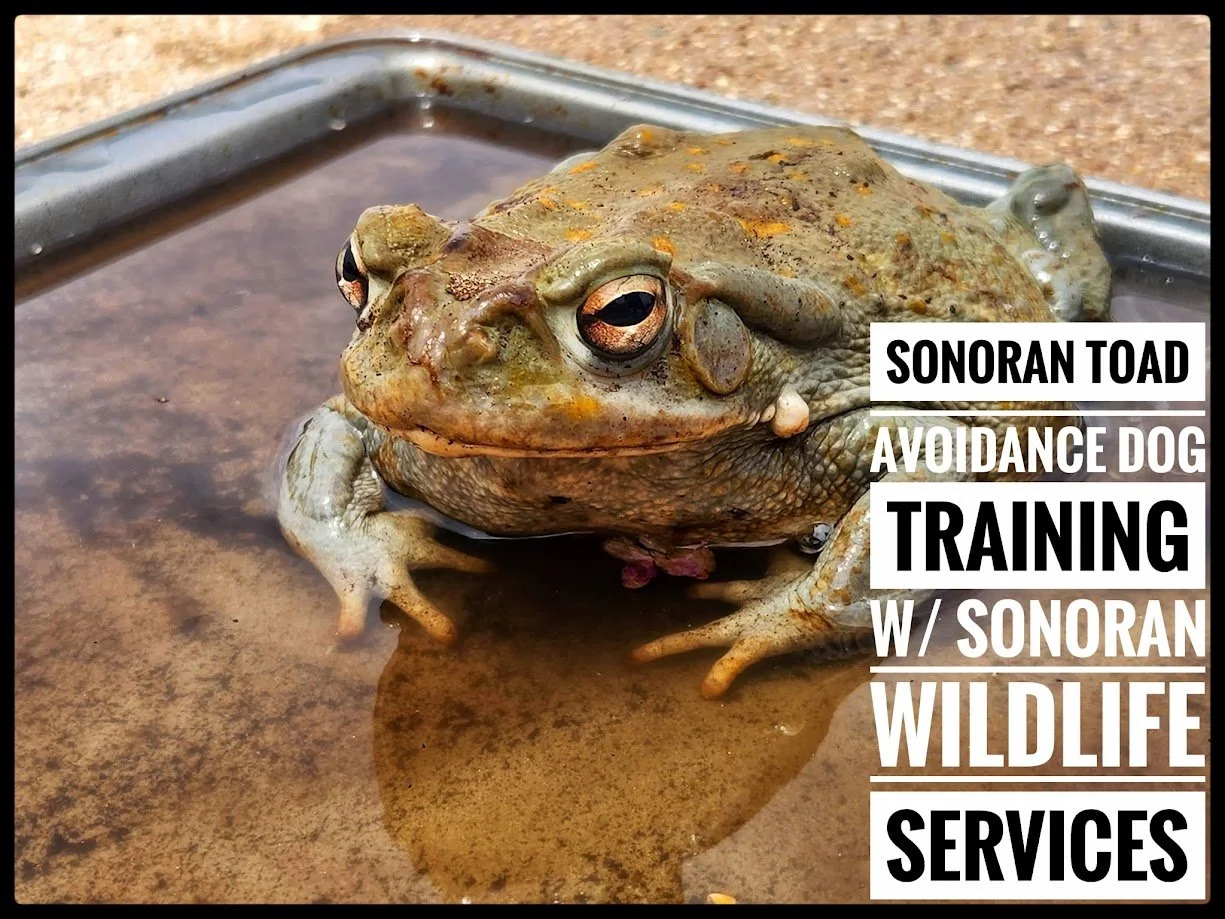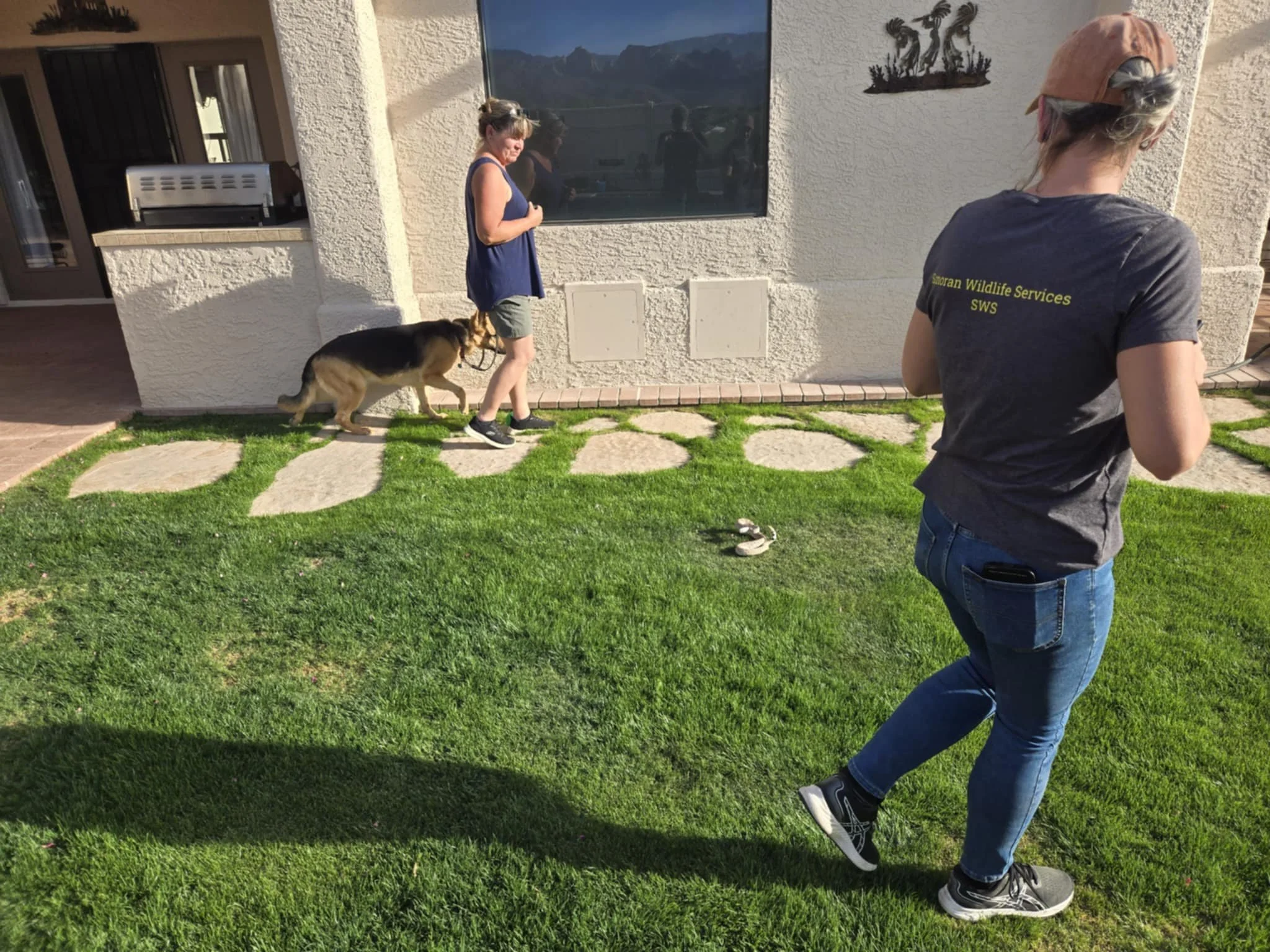Rattlesnake & Sonoran Toad
Avoidance Training for Dogs
Call or Text: (520) 909-1420
• Licensed • Insured • Bonded •
- Class Dates & Locations -
Saturday September 13th, Ranch Property, Tanque Verde/Bear Canyon
Sunday September 21st, Bark Ave Dog Wash, Speedway/Pantano
Or have us out for private at-home training!
Sunday October 12th, Ranch Property, Tanque Verde/Bear Canyon
Saturday October 25th, Bark Ave Dog Wash, Speedway/Pantano
Call or Text (520) 909-1420 to schedule or chat about your situation.
* Rattlesnake and Sonoran Toad trainings must be done in different sessions, they cannot be done in the same day. The same price applies for both. *
Follow SWS on Facebook & Instagram to see what wildlife antics we’re up to!
Snakes, Squirrels or Skunks.. SWS has you covered!
* While training cannot be guaranteed due to animal behavior and environmental factors, our goal is to give your dog the best chance possible in a real-life situation. We are essentially ‘killing the curiosity’ in a safe and controlled environment. *
- General Info - FAQ below -
Pricing, Locations or Private: First time training dogs are $120 and refreshing dogs are $60. We have two training locations on the east side of Tucson, Bark Ave Dog Wash & a Private Ranch Property. Training at Bark Ave is done within a fenced-in dog yard adjacent to the building. Training at the Ranch Property takes place in a secured tennis court area with ample space. It can be good to switch between locations for training!
Private at-home training cost is $300, which covers up to two dogs. Additional dogs are then $90 each. We bring our snakes, or toad, and multi-point course set-up to you, for training in your own yard. Reach out to neighbors and friends, let’s get a group together for avoidance training; keep the community safe and aware of our wild neighbors!
What dogs qualify for training? 6 months of age is minimum, up to seniors - All breeds & sizes welcome! Many senior age pups come through training and still do great; visual, hearing or other impairments can lessen the overall effectiveness, but in most cases, it is still better to be safe and see how training goes. Old dogs can learn new tricks! If your dog has major health concerns, we can chat about your specific situation.
How Training Works & Refreshers: We have a multi-point course set up that focuses on the Scent, Sight and Sound of our live, intact, muzzled rattlesnakes. An electric shock collar is used to teach the dog that the scent, sight and sound of the rattlesnake is a bad thing; most dogs quickly learn to avoid the three S’s and present typical avoidance behavior. We are essentially killing their curiosity, in a safe and controlled environment.
• The first station we encounter is a scented fake snake that the dogs are allowed to get their nose on directly. Moving forward, we have two securely muzzled adult rattlesnakes, one who will be rattling and the other who will be silent, plus an additional scent station.
Each dog goes through the course individually and on average takes 15minutes.
• Before training starts, we will chat about your individual situation and go over what to expect during training, as well as afterwards. You, the owners, will be right there walking with me and your dog through the course and will be instructed on what to do.
• We always recommend refreshing / retesting yearly, this is initially a no e-collar walk by of our snakes or toads to read the dogs behavior and ensure they are still appropriately avoiding. If they need a reminder, the e-collar will be used and the full course repeated.
— Some dogs may not see a rattlesnake or Sonoran toad within the year past training, so a retest walk-by is a great and simple way to bring it back to the forefront of their minds! All dogs are individuals, some learn and associate better than others, sometimes they need to come through more than once, and that is okay! While training cannot be guaranteed due to animal behavior and environmental factors, our goal is to give your dog the best chance possible in a real-life situation and to avoid the trauma and cost that comes from a failed rattlesnake or toad encounter, for both you and your dog.
What do you need to bring for training? Yourself and your pup(s)!
We ask that you come to class with a well fitting collar or harness that is correctly adjusted. If collar or harness is too loose when you arrive, we will ask that they be tightened to a snug fit before starting. Your dog will be pulling / trying to back away, we do not want slipped collars or harnesses. Retractable leashes will not be used during training, if that is what you have, we will switch to a standard lead before starting. It is okay if your pup arrives with other ‘accessories’ like their own e-collar, other training collars, gentle leaders, etc. We will ask that the leash be switched off of those or they be removed while we do training, so there is not a double-correction while on the course. Lastly, we suggest you come in comfy and sensible footwear!
About Our Snakes & Toads: Our rattlesnakes are fully intact, venom glands/fangs not removed, to ensure the most realistic training available. Dogs have an incredibly acute sense of smell, the seemingly small factor of having their glands makes a difference in the snake’s overall scent profile to your dog. The snakes are temporarily muzzled with surgical tape before training and is promptly removed once class is done for the day. Our Sonoran toads are, well, all natural Sonoran toads! There isn’t much room for interpretation there. All of our working animals are greatly appreciated, respected and cared for. We couldn’t do this with out them!
-
My dog went up to a dead snake? – This doesn’t mean training didn’t work, just that dogs like gross stinky dead things of any kind. Once it has been dead for even a short time, or blood has been exposed, that scent changes and is no longer what we trained with. Still keep dogs away and use a stick/tool to move dead R.snakes if needed, they can still potentially envenomate after death for several hours.
Does this work for all snake species or just Rattlesnakes? Sonoran Toads vs. all toads – This is R.snake specific training, they have a distinct scent profile to the dog, which their venom glands are a big part of, they also have a sound (usually), and a defensive behavior. These things make R.snakes different than non-rattlesnake species to the dogs, they have shown us many times over that they do in fact know the difference between R.snakes and non-R.snake species of snake. Dogs are individuals though, some may avoid non-R.snakes as well, while some dogs may still show curiosity towards our harmless species of snake when encountered.
Same goes for our Sonoran Toads, it is training specific to them and their unique scent and profile. If you need help identifying snake or toad species, you’re welcome to send us photos!
What if my dog doesn’t notice a R.snake? – There are several factors that go into your dog noticing and avoiding a R.snake. Several environmental factors attribute to the dog’s awareness and ability to smell/see/hear the snake. Wind speed/direction, temperature, humidity and camouflaged surroundings all play a role in daily life. But, dogs are smart and will keep themselves safe, when a R.snake is detected, they will remember, and know to avoid the situation, rather than being curious and getting too close. They need to know it is there in order to avoid; dogs present specific behaviors associated with avoidance, watching your dog during training will teach you what to look for afterwards & recognizing their avoidance behaviors in the real world can keep you both safe! -
Do we have to do this again? / How long will my dog remember training? - Dogs are individuals and some associate and learn faster or better than others do. Large majority of dogs do great with training and can avoid for years to come, but we always recommend coming back through for refresh training in the following months or year. Several factors can attribute to your dogs learning, such as breed traits, age, focus, other training, hearing/vision issues, etc.
My dog was bitten in the past, do they still need training? – Yes! Getting bit does not teach them to avoid in the future. The real pain from a bite can take several moments to hit and often times the dog does not appropriately associate the pain with the snake, which is why we use an e-collar, instant association.
Why do you use an e-collar? – An immediate negative association (the shock) is used to teach the dogs to avoid the three S’s of the R.snakes / S.toads through our multi-point course, paired with the trainer looking for specific behavior ques. The shock only happens when the dog is focused on the station and is too close / curious, if they are properly avoiding, no shock! -
We encounter a lot of snakes, my dog stopped avoiding as well? – Desensitization; when R.snakes are encountered on a very frequent basis (avid hikers, field dogs, or you just have a ton of snakes in your area) dogs can overtime become less fearful of them since nothing bad (e-collar shock) is happening when frequently encountered . If this is your situation, we recommend repeating the training yearly to help upkeep the dog’s avoidance behavior. Keep snakes a bad thing after training, do not stay in the area where a R.snake was spotted, move away before praising your dog for avoiding. Staying in the area of a known R.snake with your dog and acting like everything is fine, taking photos or giving your dog treats, are ways of desensitizing them to the R.snakes and working against the avoidance training.
What if my dog did this training with someone else in the past? – Avoidance training is not all equal. There are several methods of doing this and some can be less effective than others. If you are contemplating who to use for this specialized service, there are many factors to consider. Let’s talk.
About the Trainer and the Team:
My name is Chelsea Richardson and I have been working in avoidance dog training for 5 years. I started as a snake wrangler working with multiple different trainers who specialized in this niche field, gaining experience reading dog body language and behaviors within a wide range of breeds. Learning a variety of techniques, I began going through every detail of course setup and training to continue honing my own skills and this crucial service.
This training is serious. It may only take 15minutes every year, but that can mean all the difference between a safe or failed encounter with a rattlesnake or toad. We do this to help keep all of our dogs safe. Wildlife is unpredictable and we live in their territories, let us help you and your dogs be prepared!
Quinn, the other owner of SWS, is the snake/toad handler for training. We work as a two person team for several reasons, he has a lot of responsibilities and things to watch so that I can focus on your dog. Thank you to him and to both of our locations that allow us to do training! *Interested in hosting classes with us? Let’s chat! *
Chelsea’s Instagram for a wide range of work, check it out!









